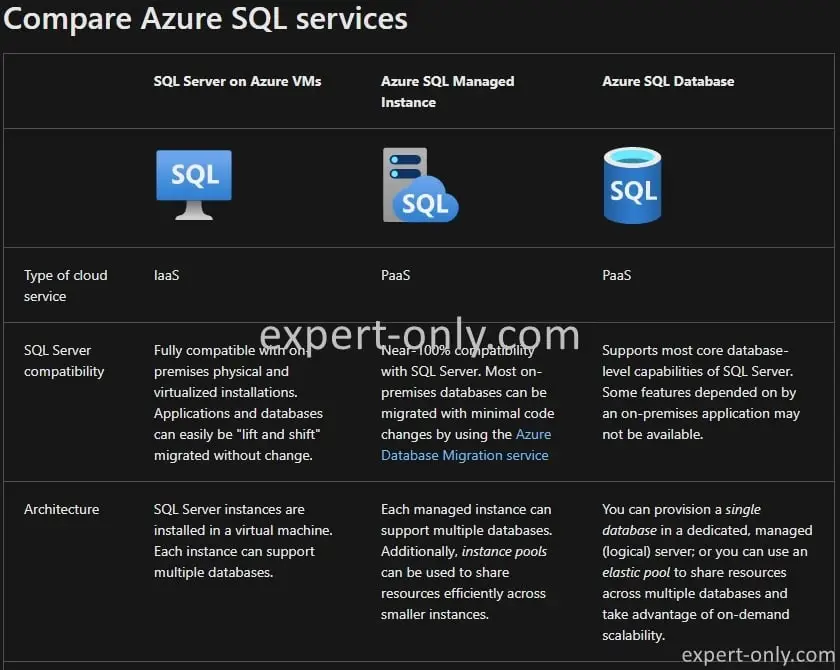This article is a concise deployment guide with the main Azure SQL Services options. Azure SQL Services offer a suite of scalable, and flexible database solutions, designed to meet the needs of modern businesses. In this tutorial, we will explore the four available deployment options and their benefits.
However Microsoft Azure offers three main options for Azure SQL Services :
- SQL Server on Azure Virtual Machines (VMs) and is IaaS type
- Azure SQL Managed Instance of PaaS type
- and Azure SQL Database also PaaS type
The fourth option is dedicated to IoT and is called Azure SQL Edge. Learn about the key features, use cases, and benefits of each option. This guide can help you make an informed decision when choosing the best solution for your organization.

Table of Contents
1. SQL Server on Azure Virtual Machines (VMs)
Azure SQL Server on VMs is an IaaS solution designed to run SQL Server on a virtual machine. So the VM is hosted in the Azure cloud. This option is ideal for organizations seeking a seamless lift and shift migration of their existing on-premises SQL Server installations. With this solution, you maintain full control over server and database configurations. Hence making it suitable for hybrid deployments and applications that require access to specific operating system features.
Key Benefits for SQL Server on Azure VMs option for SQL Services
- Easily migrate existing SQL Server installations without major changes.
- Retain full control over server and database configurations.
- Perfect for hybrid deployments and applications requiring OS-level features.
2. Azure SQL Managed Instance
The option called Azure SQL Managed Instance is a Platform-as-a-Service, i.e. a PaaS solution that offers near-100% compatibility with on-premises SQL Server instances while abstracting the underlying hardware and operating system. This service simplifies database management by automating software updates, backups, and other maintenance tasks, thereby reducing the administrative burden associated with supporting a database server instance.
Key Benefits for Azure SQL Managed instances for SQL Services
- Near-100% compatibility with on-premises SQL Server instances.
- Simplified database management with automated updates, backups, and maintenance tasks.
- Ideal for most cloud migration scenarios with minimal changes to existing applications.
3. Azure SQL Database
Azure SQL Database is a fully managed, highly scalable PaaS database service designed specifically for cloud applications. This service supports most core database-level capabilities of on-premises SQL Server, making it a suitable option for creating new applications in the cloud or migrating applications with minimal instance-level dependencies. It is available in two configurations: Single Database and Elastic Pool.
Azure SQL Database single database configuration
Single Database is designed for setting up and running a single SQL Server database in the cloud. Microsoft manages the server, and you only need to configure the database, create tables, and populate them with data. The database can be scaled to accommodate more storage space, memory, or processing power as needed. You can also opt for a serverless configuration where resources are automatically scaled and allocated as required.
Azure SQL Database Elastic Pool, configuration
Elastic Pool, on the other hand, enables multiple databases to share resources such as memory, data storage, and processing power through a pool. This model is useful for databases with varying resource requirements, helping to reduce costs and optimize resource usage. Elastic Pool allows you to efficiently allocate and release resources as needed.
Azure SQL Database is commonly used for modern cloud applications, systems with variable loads, and applications requiring high availability. It provides several business benefits, such as automatic updates and patches, scalability, high availability guarantees, and advanced threat protection. Additionally, Azure SQL Database offers auditing and encryption features to secure your data and help maintain regulatory compliance.
Key Benefits for Azure SQL Database
- Fully managed and highly scalable PaaS database service.
- Supports most core database-level capabilities of SQL Server.
- Ideal for new cloud solutions or migrating applications with minimal dependencies.
A good and maybe mandatory way to get started on Azure is to create a 12 months trial Azure account and try the available options offered.
4. Azure SQL Edge is designed for IoT
Azure SQL Edge is a lightweight SQL engine optimized for Internet of Things (IoT) scenarios, designed to work efficiently with streaming time-series data. This solution enables data processing, analytics, and storage at the edge, allowing IoT devices to perform real-time analysis and minimize latency. By integrating seamlessly with other Azure services and tools, Azure SQL Edge empowers organizations to make data-driven decisions, improve operational efficiency, and harness the full potential of IoT data.
Conclusion on Azure SQL Services main deployment options
Azure SQL Services offer three powerful and flexible database solutions to cater to various business needs. SQL Server on Azure VMs is best suited for “lift and shift” migrations and applications requiring OS-level features, while Azure SQL Managed Instance is perfect for cloud migration scenarios with minimal changes.
Azure SQL Database, on the other hand, is the go-to choice for new cloud applications or migrating applications with minimal dependencies. And Azure SQL Edge is made specifically for IoT scenarios. By understanding the key features, use cases, and benefits of each option, you can make the right decision for your organization’s database requirements.
One of the key benefits of SQL Server on Azure is that it can be combined with the other tools and applications like Python. For example to automate Excel data import into a database.



Be the first to comment